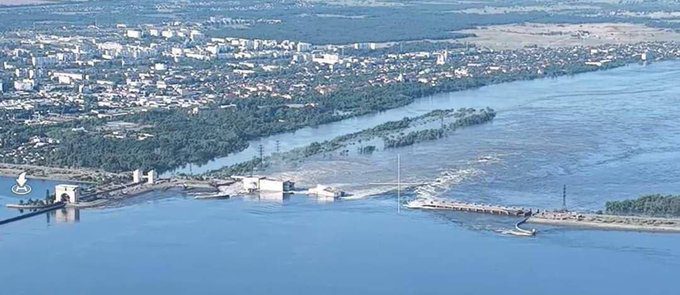
Drone footage of the destroyed dam with the Russian-controlled town of Nova Kakhovka in the background.
Evacuations are underway after alleged Russian shelling partially destroyed the Nova Kakhovka hydroelectric power plant on the Dnipro River in the southern Ukrainian Kherson oblast on early Tuesday, June 6th, CNN reported. In the wake of the attack, Kyiv accused Russia of “ecocide,” and told citizens in the vicinity to “do everything you can to save your life.”
The Nova Kakhovka dam, which holds back around 18 cubic kilometers of water—the equivalent of the Great Salt Lake in the U.S.—is upstream from multiple villages and towns, including Kherson city which housed over 300 thousand inhabitants before the Russian invasion started.
According to Kyiv, the move to flood the area downstream from the dam is meant to “create obstacles” for the much-anticipated summer counter-offensive of Ukrainian forces, showing that Moscow thinks only in terms of short-term situational advantages while completely disregarding the “catastrophic consequences.”
The destruction of the dam “only confirms for the whole world” that Russian forces “must be expelled from every corner of Ukrainian land,” President Volodymyr Zelensky said after convening an emergency meeting of security chiefs in Kyiv.
Russian terrorists. The destruction of the Kakhovka hydroelectric power plant dam only confirms for the whole world that they must be expelled from every corner of Ukrainian land. Not a single meter should be left to them, because they use every meter for terror. It’s only… pic.twitter.com/ErBog1gRhH
— Володимир Зеленський (@ZelenskyyUa) June 6, 2023
“This is ecocide,” Andriy Yermak, the head of the Office of the President said, adding that the Russians are responsible for the possible destruction of entire settlements and nearby biosphere, as well as for deprivation of drinking water in half of the Kherson region and Crimea.
EU Council President Charles Michel took to Twitter to voice his disdain, saying that the “unprecedented attack … clearly qualifies as a war crime.”
The head of Kherson region’s military administration, Oleksandr Prokudin, issued mass evacuation orders in the early hours of Tuesday on Telegram, urging citizens to “collect your documents and most needed belongings and wait for evacuation buses.” He added,
I ask you to do everything you can to save your life. Leave the dangerous areas immediately.
The evacuation orders have been sent out to the citizens of ten villages so far, as well as part of Kherson city and its surrounding islands. This leaves around 16 thousand people in the “critical zone” on the Ukrainian-controlled west bank of the Dnipro, of which over 700 had been evacuated by 10:00 a.m. local time.
“Water is coming. The situation is complicated by the fact that some roads are being washed away,” Kyiv’s Internal Affairs Minister Ihor Klymenko said in a briefing about the state of the rescue mission. “This makes it impossible to drive to some settlements. Evacuation teams are looking for other ways.”
The Russian side, currently occupying the eastern bank of the river—and, therefore, just as much in danger of flooding as the Ukrainians—denied involvement in the attack and played down the seriousness of the situation.
According to the Russian mayor of the occupied town of Nova Kakhovka, the attack on the dam is “a serious terrorist act,” but there was no urgent need for evacuation.
“There is no threat to people’s lives,” another Russia-installed Kherson official stated, adding that water levels are being measured and everything is under control on the east bank. “If necessary, we are ready to evacuate the residents of embankment villages, buses are being prepared.”
Some analysts and security experts already raised questions about Russia’s alleged motivation for the attack, pointing out the fact that the flooding will affect the occupied side of the river much more than the liberated one, and would even make counter-offensive advancements easier once the water level has decreased, not to mention that the entire Crimea—Russian controlled since 2014—could be left without drinking water because of it. Those dismissing these speculations, however, say the attack is clearly the case of scorched earth tactics.
NEWS UPDATE & ANALYSIS NOVA KAKHOVKA DAM DESTROYED MORNING JUNE 6
— Mikael Valtersson (@MikaelValterss1) June 6, 2023
The very large hydroelectric powerplant (HPP) dam over the Dniepr in northern Kherson oblast (region) has even destroyed. Exactly what happened is unclear Ukraine and its western allies blame Russia. Some russian… pic.twitter.com/2tqMex44Zh
Flooding is not the only issue Ukrainian emergency services are currently monitoring, as the Kakhovka reservoir also provides critical cooling water for the Zaporizhzhia nuclear plant, located upstream, therefore not in direct danger, from the broken dam.
According to the spokesman of Ukraine’s southern command, the dam’s destruction will “certainly” affect the operation of the nuclear plant but there was “no need to escalate the situation now and draw the most critical conclusions.” The cooling pond is currently full, he added, so “the situation is under control.”
